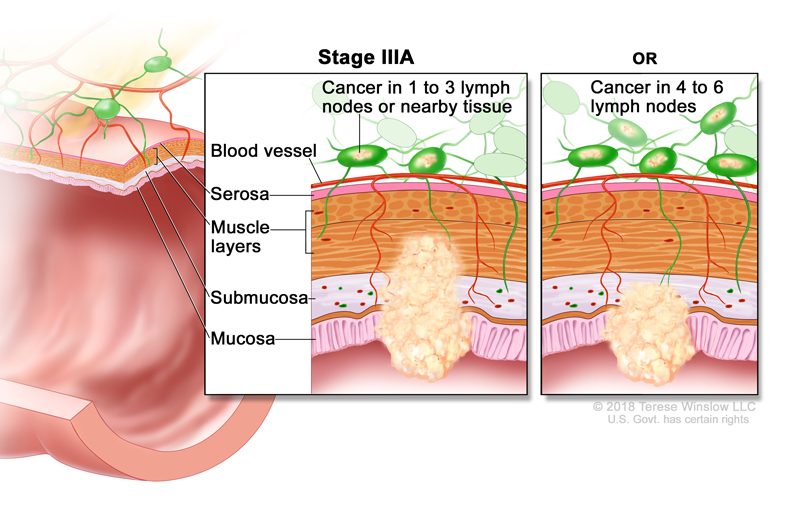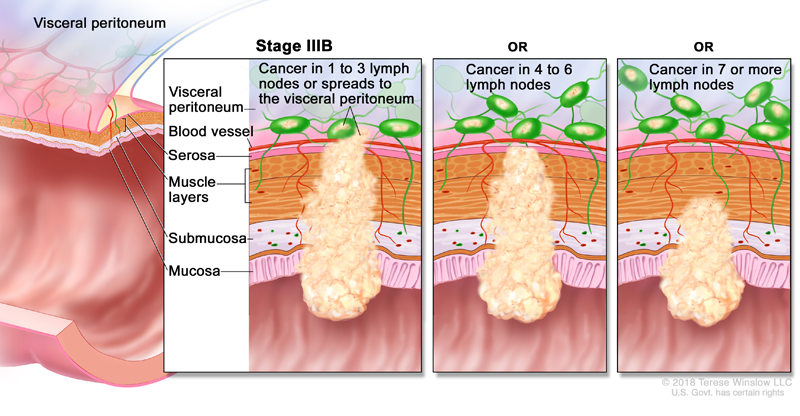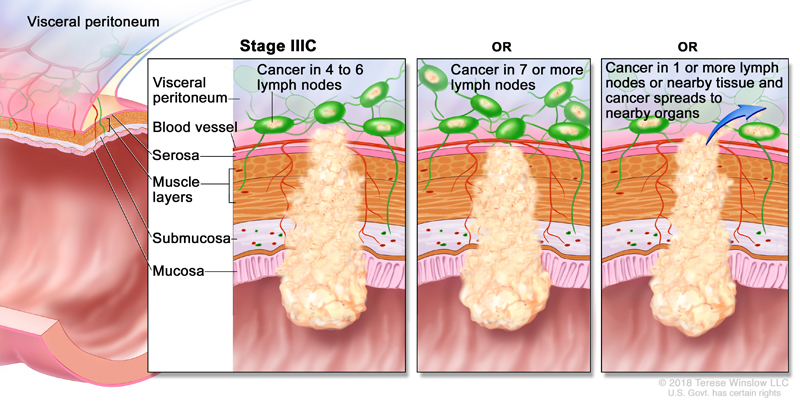Overview
A Stage 3 Colon Cancer diagnosis is divided into three stages, Stage 3A, Stage 3B and Stage 3C. In all Stage 3 Colon Cancer Stages, the cancer has spread to nearby lymph nodes, but has not yet spread to any other parts of your body.
Tap “Watch Now” for an easy-to-understand overview of Stage 3 Colon Cancer.
- Stage 3A Colon Cancer
- Stage 3B Colon Cancer
- Stage 3C Colon Cancer
Overview
Stage 3A Colon Cancer diagnosis is when:
A) The cancer has spread to the intermediate layers of your colon, called the Submucosa or Muscle layers and has affected 1-3 of your lymph nodes or nearby tissue as shown in the left image,
or
B) The cancer has only spread to the superficial layers of your colon called the mucosa and submucosa and has affected 4-6 lymph nodes as shown in the image on the right.
What Tests Will I Need and Why?
Blood and Imaging tests are done to understand your general health, confirm your diagnosis and determine your cancer stage.
A test, called a Colonoscopy, is usually the first step to see if there is a tumor inside of your colon and if needed, to take tissue samples for analysis. This test, inserts a thin tube with a camera into your anus to see the inside of your colon.
Tissue analysis is also typically done through a biopsy to identify the cancer cell type, which is critical to finding the best treatment option for you.
Re-read this summary as needed and then tap, “Compare My Treatment Options Now“. Our unique Comparison Page will help you understand your FDA-approved treatment options including, who can help you pay for your treatment, where and how each is given and what side-effects you may experience.

National Institute of Health/ treatment-colon
Overview
Stage 3B Colon Cancer is when one of the following is taking place:
1. The Cancer has spread to the deepest layer of your colon called the Serosa or the tissue that covers most of the organs in your abdomen called the visceral peritoneum or has affected 1-3 lymph nodes seen here on the left.
or
2. The Cancer has spread to 4-6 lymph nodes shown here in the middle image,
or
3. The Cancer has spread to the top and intermediate layers of your colon and has affected 7 or more lymph nodes.
What Tests Will I Need and Why?
Blood and Imaging tests are done to understand your general health, confirm your diagnosis and determine your cancer stage.
A test, called a Colonoscopy, is usually the first step to see if there is a tumor inside of your colon and if needed, to take tissue samples for analysis. This test, inserts a thin tube with a camera into your anus to see the inside of your colon.
Tissue analysis is also typically done through a biopsy to identify the cancer cell type, which is critical to finding the best treatment option for you.
Re-read this summary as needed and then tap, “Compare My Treatment Options Now“. Our unique Comparison Page will help you understand your FDA-approved treatment options including, who can help you pay for your treatment, where and how each is given and what side-effects you may experience.

National Institute of Health/ treatment-colon
Overview
Stage 3C Colon Cancer is when one of the following is taking place:
1. The colon cancer has spread to the tissue that covers most of the organs in your abdomen called the peritoneum and has affected 4-6 lymph nodes seen here in green,
or
2. The colon cancer has spread to the deepest layer of your colon called the Serosa or the tissue that covers most of the organs in your abdomen (peritoneum) and has affected 7 or more lymph nodes shown here in the middle image,
or
3. The colon cancer has spread to nearby organs such as the kidney, cervix, the vagina in women, or the prostate in men and has affected at least 1 lymph node or nearby tissue.
What Tests Will I Need and Why?
Blood and Imaging tests are done to understand your general health, confirm your diagnosis and determine your cancer stage.
A test, called a Colonoscopy, is usually the first step to see if there is a tumor inside of your colon and if needed, to take tissue samples for analysis. This test, inserts a thin tube with a camera into your anus to see the inside of your colon.
Tissue analysis is also typically done through a biopsy to identify the cancer cell type, which is critical to finding the best treatment option for you.
Re-read this summary as needed and then tap, “Compare My Treatment Options Now“. Our unique Comparison Page will help you understand your FDA-approved treatment options including, who can help you pay for your treatment, where and how each is given and what side-effects you may experience.

National Institute of Health/ treatment-colon
Recommended Colon Cancer Videos

Colorectal Cancer Overview

The 4 Stages of Colon Cancer in 3D
Colorectal Cancer Prevention: Dr. Mark Pochapin on Colonoscopy & Polypectomy

How Cancer Spreads
Metastatic = Advanced

Diagnosing Your Cancer
How Does a PET Scan Work?

Diagnosing Your Cancer
How Does a CT Scan Work?

Get Up & Get Moving
From Your Friends @ the Oncology Nursing Society
Commonly Searched Questions
Stage 3 colon cancer definition.
Stage 3 colon cancer is when a mass of cells called a tumor spreads (metastasizes) beyond the lining of the colon to nearby lymph nodes—small structures that are part of the immune system. Although the lymph nodes will contain cancer cells, the disease will not yet have spread to distant organs in the body, such as the liver or lungs.
Source: Cancer.org
Stage 3 colon cancer survival rate.
According to SEER data, Stage 3 Colon Cancer has a survival rate of 72.8%. For example, if the 5-year relative survival rate for a specific stage of colon cancer is 72.8%, it means that patients who have that cancer are, on average, about 72.8% as likely as patients who don’t have that cancer to live for at least 5 years after being diagnosed.
Source: Cancer.gov
Stage 3 colon cancer symptoms.
Colon cancer symptoms are more noticeable in stages 3 and 4. These includes:
- changes in stool color
- changes in stool shape, such as narrowed stool
- blood in the stool
- excessive fatigue
- vomiting
- constipation/diarrhea
- abdominal cramps
Source: Cancer.org
Stage 3 colon cancer recurrence rate.
The overall prognosis for stage 3 colorectal cancer shows an excellent outcome of 72.8% for the 5-year survival rate, and 31% of the patients still experience recurrence.
Source: PubMed.gov
Stage 3 colon cancer treatment.
Stage 3 colon cancers have spread to nearby lymph nodes, but they have not yet spread to other parts of the body.
Surgery to remove the section of the colon with cancer (partial colectomy) along with nearby lymph nodes, followed by adjuvant chemo is the standard treatment for this stage.
Source: Cancer.org















